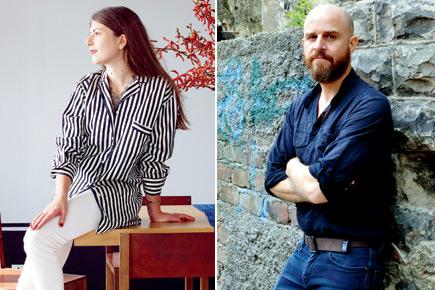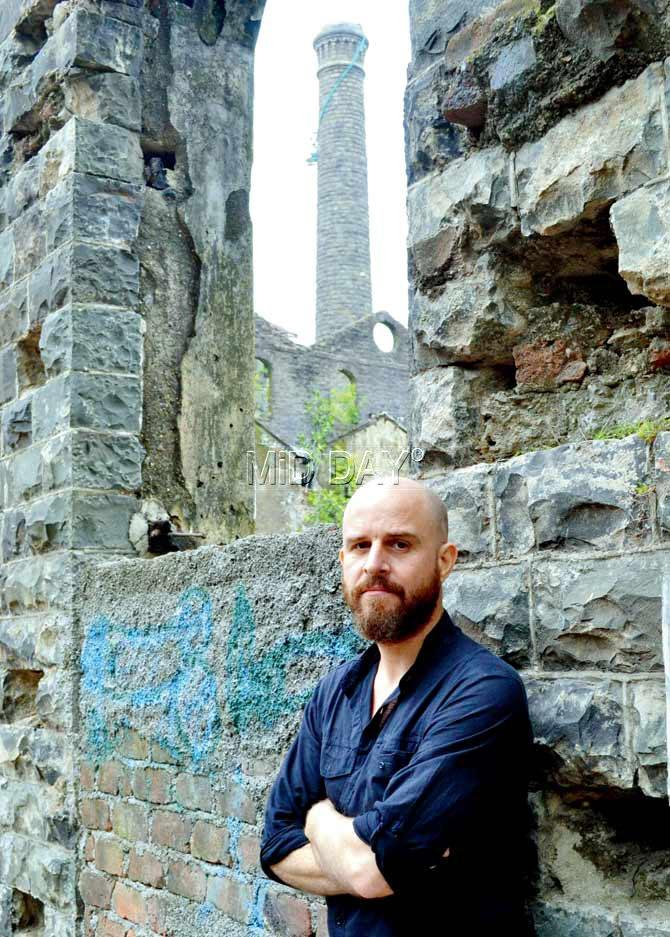In the second part of our series on non-Indian professionals living in Mumbai, we speak with French artiste and fashion photographer, Fabien Charuau, who credits the city for inspiring him to become an artist; and owner of fashion and home store (Le Mill), Cecilia Morelli Parikh, who embraced Mumbai after her marriage

For Cecilia Morelli Parikh, accepting the fact that Mumbai would now be home was not an easy transition. The American-born (part Italian and part French) left her job as a buyer for Bergdorf Goodman to launch Vogue in India as part of the editorial team in May 2007.

Cecilia Morelli Parikh at her home at Marine Drive. pic courtesy/Gaelle Le Boulicaut
ADVERTISEMENT
“It was also more tropical than I had expected; I lived very close to a lot of trees in Colaba, and I didn’t expect this. I arrived during the monsoon, so my first impressions were very wet! Once I got used to wearing shoes I was happy to toss; I came to love the very specific energy of Bombay (Mumbai); especially its people. It always seems like a city where anything is possible, albeit with a lot of hard work,” she recalls.
Parikh feels that though she leads a comfortable life with everything one could ask for, life in the city can be tough. “I first realised Mumbai will now be home when I married Rohan (Parikh), in 2010. Rohan was born and raised here, and his company is based here. At first, I was not happy, as I was a professional and had left behind my job in New York. I was worried. Gradually, it felt better,” she explains. Parikh went on to set up Le Mill (with Julie Leymarie and Aurélie De Limelette), one of the most celebrated home and fashion stores in the city and has not looked back since then.
Eat, sleep, relax, repeat
Innovation is the key aspect for Parikh to fall in love with a place, “I love eating at The Table and Ellipsis as they are very innovative, be it the design or food.” Traditional picks include Soam and Chetana. “I don’t eat meat. So, whenever I am out and need to pick up lunch, Soam is my choice. Also, I love Indian food, but not oil and milk, so this makes for a healthy way of eating,” she feels.
Parikh adds that she is privileged to have a trainer, and a masseuse, who is a good friend come home too. But when she needs to relax, a Balinese massage at The Palms Spa at Dhanraj Mahal in Colaba gets booked.
In search for art
“The contemporary art scene in India is the space I am most excited about today. I feel once the Delhi Art Fair gets its recognition, and with the Kochi Biennale making its mark, the art scenario in the country should get stronger. In Mumbai, Chemould Prescott Road gallery and Project 88 are two of the strongest galleries. They include a roaster of great artists,” shares Parikh. She tells us that she is also in love with the Dr Bhau Daji Lad City Museum and their contemporary art partnerships, especially for the manner in which they have revamped a heritage structure as a contemporary art space.
What to shop
Parikh is fan of her own store for obvious reasons, but one of her favourites is Khazir Khazana at The Oberoi, which stocks pashminas in modern designs (one of the first places in India where she spotted a striped pashmina she tells us). Another recent find takes her northward from her SoBo domain — Hindoostan Revisited in Dadar, that offers incredible old maps and beautiful gouaches from the 19th century at very affordable prices. Parikh rues that there aren’t any good stores that stock Indian vintage jewellery; though she loves contemporary jewellery by Nirav Modi, “for browsing and dreaming”.
Mumbai’s local
We are surprised to hear popular French artist and fashion photographer, 41-year-old Fabien Charuau speak in what he calls Bambaiya Hindi, when we meet him. We get an essence of what the city means to him at the beginning of our conversation, where he refers to everything Mumbai and Indian as “our”. With a warm smile, he warns us, “Don’t go by the colour of my skin, I’m very Indian.”
First shot
“I came here to become a mechanical engineer and study in IIT Delhi, in the 1990s. I came back to Mumbai in 1999 to work for a French engineering company, which I did, and got posted in Bangalore. I wasn’t happy being an engineer. I met Bengaluru -based photographer, Prabuddha Dasgupta, in the early 2003. We had a few common friends, so I showed him some of my photos, then I would be at some of his shoots, and realised that this was what I wanted to do. I assisted him for a year and half in Bengaluru. Bangalore (at the time) was a very small market and there wasn’t much to do as a fashion photographer. So, I moved back to Mumbai. I started shooting fashion and moved to advertising. Now, I have been working as an artist. The past year has been great as I have been able to manage my time. I write on photography and teach as well,” he reveals.

Fabien Charuau at one of Mumbai’s deserted mill compounds. Pic/Datta Kumbhar
Mumbai mania
“I love the city. I can’t function outside or live elsewhere. It is part of me. I have never been in the same place for so long. The man and the artist that I am, was formed by this city, the way I live here, the people I meet, and its architecture,” he says. The city’s work ethic has been a contributing factor to Charuau’s admiration. “Since I started my career here, I am used to its pace. If I have an exhibition in France, I find it difficult to work there. It’s about the relationships; in Bombay (Mumbai) I manage. If something’s not working, you make a call, people help you fix it, In Europe, you have to take appointments and nothing can be done last-minute. We work very hard here. The energy helps me push myself better,” he maintains.
The artist’s muse
However, when talk moves to inspiring spaces, he admits that it is getting increasingly difficult to shoot outdoors as permissions are expensive. “Aesthetically, I love shooting in industrial zones. I find areas like Reay Road and P D’Mello Road attractive, as these exist despite the odds,” he beams. “My art projects are rooted in the people I meet. I deal with what is happening on the streets. A recent project deals with the aggression that women face on streets on a daily basis. Mumbai isn’t the worst city, as it is considered safer, but still, many women deal with it, daily. There’s also an Internet project, called Online Darshan, that talks about how you can now pray in front of the computer. I love to see how access to technology affects the people on the streets of Mumbai,” he shares.
In another project, Charuau looks at how Bandstand and Reclamation are dotted with couples. “Earlier, it would be middle class and upper middle class; now, it’s the lower classes as well. Everyone from the age of 15 wants to have a girlfriend or a boyfriend; it’s beautiful. A soft sexual revolution is taking place here. Remember the protest about kissing to be able to show their affection? When you start having a girlfriend at 15, you will look at women differently. When you love someone, you learn to respect the person. Such a guy won’t start shooting women on the street after five years. A while back, Bollywood movie endings always depicted the couple getting married. This has changed,” he explains, pointing further that, “This project was inspired by what I saw in the city. It is not in-your-face but a huge step for safety in the city. It is a change for the better.”
The wishlist
“I lived in South Mumbai earlier, and I have seen the shift focussing towards the north. A lot has been happening in Versova, Juhu and Bandra; the south is getting emptier — in terms of cultural events and nightlife. However, south Mumbai’s beautiful parts remain Fort and Kala Ghoda,” he says.
He feels that as far as public places for exhibitions go, Mumbai is far away. “I love Dr Bhau Daji Lad City Museum. Mumbai is not the biggest market for art; perhaps this is why galleries here take a lot of risk. I find that interesting. Chatterjee and Lal, Project 88 and galleries on that stretch of the road, do engaging projects. I like the witty, graffiti street art in Bandra. I would love to see the art scene move northward,” he concludes, before rushing off to check the frames of his next exhibition.
 Subscribe today by clicking the link and stay updated with the latest news!" Click here!
Subscribe today by clicking the link and stay updated with the latest news!" Click here!







